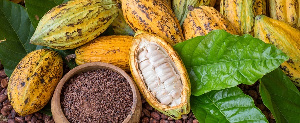 Women have smaller plots for cocoa farming than men
Women have smaller plots for cocoa farming than men
Land ownership and acquisition for cocoa cultivation by young people under age 30 who are interested in the commodity has become difficult, with major cocoa land owners falling within the 50-65 age bracket, a finding by the Agricultural Policy Research in Africa (APRA) has indicated.
At a national dissemination forum to present key findings by a team of researchers who have undertaken research in the last five years, from 2017 to 2021 in major cocoa-farming communities of the Eastern and Western Regions, it was disclosed that only 13 percent of farmers under 30 years are able to get access to land for cocoa farming.
The Sefwi-Wiawso, Juaboso, Bia and Akotombra areas of the Western North Region, and several towns in the Eastern Region, particularly Suhum, produce the largest percentage of Ghana’s cocoa – more than 60 percent.
A Cocoa Value Chain Research Lead, Prof. Kojo Amanor, at the forum explained that 65 percent of cocoa farmers within the over-65 age group and 41 percent within the 50-64 age group at Juaboso are owners of the majority of lands for cocoa cultivation.
“The size of a piece of land is usually four hectares for these adults, with young farmers finding it difficult to acquire one hectare,” he said.
Prof. Amanor however said the situation at Suhum in the Eastern Region is a bit appreciable, as the vast majority of cocoa farmers in all age categories farm less than 2.5 hectares of land – albeit with young farmers still struggling to own an appreciable size of land for cultivation.
But Dr. Richard Asare, Country Representative for the International Institute of Tropical Agriculture and Coordinator for Cocoa Research for Development, said the size of land should not necessarily kill the youth’s interest in cocoa farming.
“Probably, the rudimentary nature of cocoa cultivation is what’s killing the interest of young people who want to venture into cultivation. This means stakeholders must begin to look at ways of mechanizing cocoa farming in order to generate interest from young people,” he said.
Land ownership and women in cocoa farming
The findings also state that women, in general, have smaller plots of land for cocoa farming than men in major cocoa growing areas – a situation Prof Amanor said must be addressed to enable women to have some favourable leverage in land acquisition for cocoa cultivation.
“When the land becomes scarce, it is more difficult for women to get family land; and so there must be alternative solutions that favour women in land acquisition for cocoa farming,” he suggested.
However, the research indicated that land ownership for women differs in various geographical areas, as women in Juaboso have larger plots of land for farming than women at Suhum.
This situation, according to the research, is attributed to the expansion of cocoa farms to cover lands for food-crop farming, which were originally owned by women.
APRA, a five-year policy project on how agriculture commercialization can reduce rural poverty, empower women and girls, and improve food and nutrition security in Ghana started in March 2017.
The APRA project was hosted by the Institute of Statistical, Social and Economic Research (ISSER) with researchers from the institute.